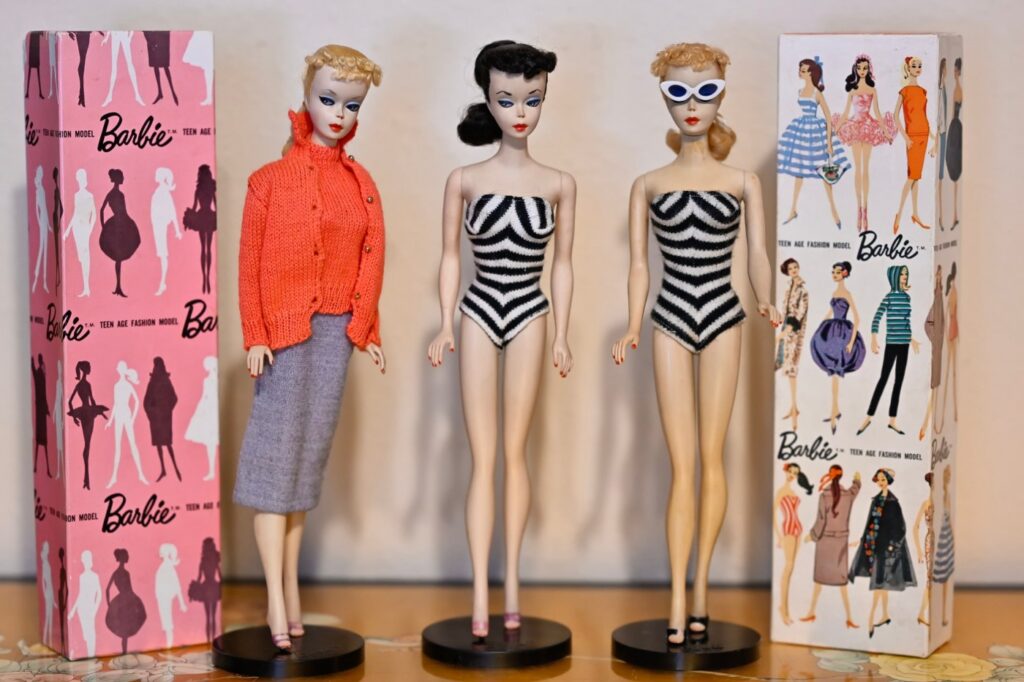
Robert Reyes is in Barbie heaven.
He’s seen the “Barbie” movie four times.
His bedroom is packed full with glass cabinets displaying Barbie and Ken dolls from the toys’ 64-year history.
And books and magazines about Barbie and her creator, Ruth Handler, lie about the house.
No, Reyes is not a teenybopper Barbie fan. He’s not “cuckoo.” And he certainly didn’t grow up playing with the dolls (that just wasn’t done back home in El Paso, Texas, he says).
The Laguna Woods resident is 62 years old, he has a doctorate in education administration, he’s a big fan of history, and he knows the value of nostalgia, especially vintage toys. In fact, he’s doing research on “the importance of play and the history of toys” for a planned coffee-table book.
Right now, Reyes especially knows that the demand for and the prices of vintage Barbies have soared since the movie’s release. According to some reports, prices have climbed about 25% in recent months.
Before Reyes started collecting Barbie dolls and all her accouterments, he would laugh at those who were fans, he says.
“I thought people who were into Barbies were cuckoo. I just didn’t ‘get’ her. Now – the artistry and design – I just love her.”
Reyes has around 500 of the dolls, he says. That includes all the Barbies and Kens, plus Barbie’s BFF Midge, Barbie’s little sister Skipper, Skipper’s friends Scooter and Ricky, and even Francie, “Barbie’s ‘MOD’ern cousin” from Britain.
He has two Barbie Dream Houses, a Barbie and Ken Little Theater, Barbie MacDonald’s, Barbie Dress Shop, Barbie Campout Tent and a Barbie Goes to College set, along with a few vinyl Barbie cases.
Reyes gets most of his pieces from EBay, but also from two national dealers who specialize in all things Barbie.
He got his first piece just seven years ago, when a friend who owned a local thrift shop was selling Barbies from the 1970s. It was a 1979 vinyl carrying case complete with a Barbie doll and small wardrobe. He paid $20.
That purchase set Reyes on a new, unexpected path. He started researching the toy, to the point where he’s now an encyclopedia of Barbie facts and figures. Most of all, he says, he “became a believer in Barbies.”
“She’s a beautiful doll. She’s an American icon, a work of art,” he says. “And she’s the best-selling toy in America to this day.”
In his collection are the earliest dolls, the Barbie Ponytail Dolls: the original one, Barbie No. 1, and Barbie No. 2, both released in 1959.
The original Barbie had holes drilled in her feet so she could fit securely on a doll stand. No. 2 didn’t have those holes; she came with a wire stand instead. Both dolls had arched eyebrows and came in black and white striped swimsuits.
The early dolls have been commanding high prices among collectors these days – more than $27,000 for Barbie No. 1, in mint condition, in the original box and never played with, according to reports.
It was also reported that a museum in Virginia recently paid a record $42,000 at auction for a 1959 first-release Barbie. Reyes says it was originally a display doll only, made exclusively for department stores.
Reyes has some even more historical pieces in his collection – a Tillie the Toiler paper cutout doll and Lilli, a German plastic doll that looks much like Barbie.
Handler, Barbie’s creator and co-founder (with her husband) of the Mattel toy company, was inspired by the cutout dolls that her daughter, Barbara, played with. Tillie, a newspaper comic strip character starting in the 1920s and later a paper doll, was an early portrayal of an independent career woman.
The prototype for Barbie was Bild-Lilli, who started out as a gold-digging sex symbol comic strip character in 1952 in Germany and became a plastic doll in 1955. Handler stumbled across Lilli the doll while on vacation in Switzerland in summer 1956, when she and her daughter passed by a toy store and saw the doll in the window.
The rest, as they say, is Barbie history, and Reyes would be more than happy to tell you all about that.
These days, Reyes is hoping to sell some of his collection: “I have run out of space, and I only need one of each, not multiples.”
Not that his partner, Patrick Kennedy, is complaining.
“He has his man cave where his Barbie dolls live,” Kennedy says, “and no, he doesn’t take them out and play with them, and they don’t encroach upon the living space.”
Mostly, Reyes says, “it’s a tremendous opportunity” to sell right now.
He recently had an auctioneer come by, who picked up some No. 1 and No. 2 Barbies. Reyes had bought the No. 1s for $13,000, he says, and hopes to get at least $32,000 each at auction. He bought the No. 2s for $6,000 to $7,000, and hopes to double his money.
The auctioneer also took Dream Houses 1 and 2, the College set, Dress Shop and Theater. Reyes had paid $300 to $500 for each set and hopes to get at least $1,000 apiece.
Ultimately, Reyes would like for his pieces to go to museums, to preserve what he calls “part of American culture and history.”
And he’ll keep some of the dolls for himself.
As for the movie? Reyes says it offers something for everyone.
“If you hate Barbies, you’re gonna like the movie. If you love Barbies, you’re gonna love the movie.”
